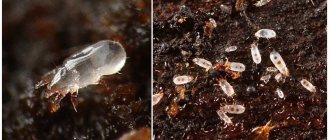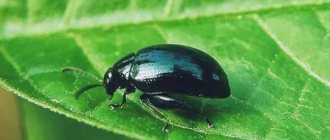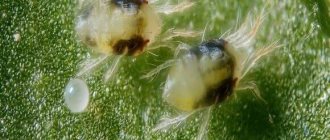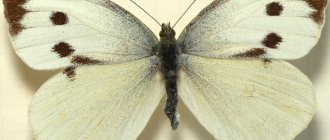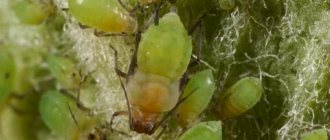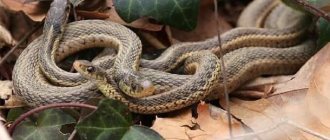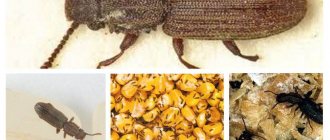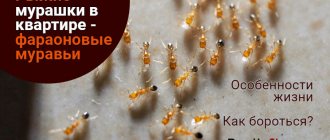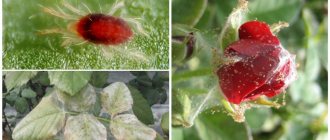- Types of barn mites
- Tick habitats
- What harm do barn mites cause?
- Measures to combat granary mites
Barn mites are microscopic pests belonging to the arthropod family. They feed on all types of agricultural products stored in warehouses, causing irreparable harm to producers and human health.
Description of the tick
The mealy mite is considered one of the most harmful insects. It not only spoils cereals, seeds, herbs, and food, but can also cause the development of serious human diseases. In order to fight it, it is necessary to study in detail information about the pest.
This is one of the insects that exhibit sexual dimorphism (differences in the appearance of the female and the male). The male individual has a body length of no more than 0.43 mm, so it is quite difficult to notice with the naked eye. The main distinguishing feature of males is their thickened front legs, which have a conical tooth. The female mealy mite is approximately one and a half times larger than the male. The length of the female’s almost colorless body can reach 0.67 mm. The head of such an insect is pale brown, and the legs are yellowish.
The body of both individuals of the grain mite has a slight rounding at the end. There are 4 pairs of legs on it, each having approximately the same length. They have microscopic suction cups that help the insect stay on the plant.
Principles of classification
Ticks are the oldest invertebrates with a primitive structure.
Their miniature body size helps them spread and survive everywhere. Their body is divided into two parts, the border is located closer to the front. Four pairs of legs consist of several segments, the final one is a tarsus, armed with claws and suckers. The first pair of appendages, chelicerae or jaws, are characteristic of all arachnids. They look like pincers and are used for piercing and cutting. The oral apparatus also includes pedipalps, limbs located on the side of the chelicerae. These processes grow together at the base and, together with other parts, form a movable head. There are some differences in the structure of the oral organ, depending on the type of nutrition. In saprophages that eat dead remains, it is gnawing, while in predators and parasites it is piercing-sucking.
Classification
Most species of mites are predators and saprophages. They live independently and do not need to parasitize other individuals to develop. Scientists divide the Acari subclass into three superorders:
- Harvester ticks (Opilioacaridae) are large terrestrial individuals measuring 1-3 mm in size. There are 25 known species inhabiting the tropics and subtropics. Their head and thoracic region merge into the cephalothorax, delimited from the abdomen. The oral apparatus consists of chelicerae, pedipalps and upper lip. On the back there are three pairs of eyes. Their long legs make them look like harvestmen. Representatives of the family live in the forest, under stones, and in the soil. They feed on solid food, including small arthropods, plant pollen and fungal spores.
- Parasitiformes are a superorder with 12.5 species. This group includes parasites of vertebrates, as well as predators and saprotrophs (individuals that destroy the remains of living beings). Among the most dangerous representatives of the superorder are ixodid and argasid ticks.
- Acarimorphic mites (Acariformes) are the largest group, which includes more than 30 thousand species. Individuals of the family are characterized by the addition of segments throughout life. About half of the group consists of sarcoptiform mites, which parasitize vertebrate animals. They feed on feathers, skin, and hair. Thrombidyphoid mites (almost 22 thousand species) include plant pests and carriers of infectious diseases.
Variety of tick species
Tick species have different feeding preferences. Some feed on plant sap, others on rotting organic matter, others on blood, and others on dead parts of the epidermis and fur. But there are no highly specialized species among them. If it's sap, it's the sap of many plants. If blood, then from all warm-blooded organisms living in the area.
Stages of development
The entire pest development cycle can take about 2 weeks. During this time, the born insect turns into an adult, which is capable of mating and laying eggs.
The life cycle of such a tick begins with mating. This whole process is quite lengthy and takes several hours. During it, you can observe a “mating walk”, in which a larger female leads a backing male. As soon as fertilization occurs, individuals move away from each other.
The development cycle of an individual mealy mite:
- Egg. A few days after mating, the female begins to lay 3 or 4 eggs per day. In most cases, the laying place is grass seeds and various grains. If there are none nearby, then the female scatters the eggs on food. Over a full season, a female is capable of laying from 20 to 150 eggs. This large difference is due to the presence of different environmental conditions. As a rule, the incubation period lasts 3-4 days.
- Larva. She emerges from the egg looking very much like her parents. The only difference from an adult is the presence of only three pairs of legs. The larvae grow in size very quickly as they continuously eat available food. After about three days, the developing insect becomes motionless. It stays in this state for 1-2 days, and then reincarnation occurs. The protective layer of skin on the back breaks and the insect moves on to the next stage of development.
- Nymph. The duration of this stage is 7 days. At this time, the individual continues to actively feed, and then goes into a stationary state. The result of this process is the appearance of an adult.
Habitat and diet
The flour mite is perfectly adapted to life in various conditions. It can easily tolerate extremely low or high temperatures. The same applies to laid eggs, which do not die at temperatures ranging from -5 to +60 degrees Celsius.
The grain mite can settle in the following places:
- warehouses where grain crops are stored;
- accumulations of straw;
- haystacks;
- livestock habitats;
- bakeries and other places where flour is stored;
- burrows of rodents and other small animals;
- plant remains (accumulation of autumn leaves, waste from wheat and other crops);
- cereal and corn fields;
- grocery stores;
- kitchens in private or multi-storey buildings.
The diet of mealy mites depends on the habitat. Larvae and adults can eat much more than their body weight and therefore cause serious damage to agriculture.
They eat the following foods:
- wheat and corn flour;
- flax seeds;
- rice, wheat and other cereals;
- various fruits;
- ground cereal;
- meat;
- compound feed;
- homemade baking;
- smoked meats;
- legumes;
- dried fruits;
- vegetables;
- carrion;
- tobacco;
- conservation.
Danger to humans and animals
Mealy mites cause many difficulties for workers in the agricultural industry. It eats not only the grown grain, but also young shoots that could produce a new harvest. Affected seeds are difficult to distinguish from good ones, which leads to a significant reduction in yield.
Neighborhood with these pests poses a great danger to domestic animals and humans. This is due to the fact that tick waste products contain many harmful microorganisms, including E. coli.
When a contaminated product enters the body, tick-borne anaphylaxis begins to develop (a severe allergic reaction that can be fatal). It appears within a few minutes after eating.
Main symptoms of the disease:
- severe shortness of breath;
- wet cough;
- anaphylactic shock;
- problems with the digestive and genitourinary systems;
- allergic rashes accompanied by severe itching.
If one or more of these symptoms suddenly appears, you should seek help from a doctor as quickly as possible. They will help determine the cause of the problem and find ways to get rid of it.
Pest control methods
Measures to control and prevent flour mites include a whole range of measures that are aimed at eliminating pests or preventing their occurrence. According to the method of influencing insects, all methods can be divided into 2 categories - physical and chemical.
Physical methods for exterminating grain mites:
- Heat. The pest cannot live for long at temperatures above 60 degrees Celsius. Because of this, the most effective way to get rid of the parasite is to periodically warm the cereals.
- Cooling. During the cold season, the grain storage room should be ventilated several times a day. This will help reduce the temperature to -5, which is fatal for most grain mites.
- Cleaning. At any time of the year, you should regularly sort out the grain. All spoiled and unsuitable for further use grains must be removed from the total mass. This simple action will significantly reduce the likelihood of pest occurrence.
There are several chemical ways to combat grain mites. They are based on spraying cereals with special compounds or treating the premises.
Chemical control methods:
- Products containing hydrogen phosphide (Katfos, Fumifast, Alfos and others). These chemical compounds make it possible to cover grain stocks with a thin film that will kill all pests in 24 hours.
- Special insecticides for ticks (Phostoxin, Fostek). The products are diluted in water and used to spray grain.
- Gas disinfestation. The room in which the grain is stored is treated with gas. It is important to observe the frequency of the procedure so as not to harm the grain.
- Aerosol disinfection. Nowadays, it is quite easy to find the right pest control product. Some are made in spray form, allowing for regular spraying of chemicals in barns. This measure will not only eliminate all insects, but also prevent their reappearance.
- Combined. It involves a combination of two or more methods of combating granary mites.
Argaceae
The family consists of 12 species. They have a characteristic ovoid shape. Sometimes you can even say oval. There is no point to the head. The legs are often hidden under the shell.
In some ways, these individuals resemble bedbugs. The Persian tick is constantly confused with them. How can you tell them apart? The bug has a hard chitinous cover, while argasids have a soft, leathery shell.
Their color changes due to blood. Those who are full are purple in color, while those who are hungry are gray. They can infect cats, birds, and humans. The resilience of these parasites is amazing. Some of them are capable of fasting for up to 11 years. They are waiting for the right moment.
These animals are dangerous not only because they carry tick-borne fever, relapsing fever, and borelliosis, but also because of their bite. The saliva of these arachnids is toxic, so the consequences of a bite are rash, itching, and redness. Some species are as feared by Mexicans as rattlesnakes. The toxins cause paralysis and some animals die from their bite. Mammals that are infected with Argasidae often behave restlessly. The animal becomes depressed.
Let's look at the main photos of tick types and names to understand the differences:
- Caucasian. Distribution area: Caucasus, southern Ukraine. He carries a dangerous disease - endemic relapsing fever.
- Shell-type. It often infects pigeons, and there are cases of human infection.
- Poselkovy. Carries spirochetes that cause borelliosis. Such an individual is dangerous due to the method of transmission of the disease. The arachnid can transmit the virus to its offspring. Thus, not only the tick, but also the virus multiplies.
Preventive actions
In order to avoid the appearance of flour mites, it is necessary to take preventive measures. These simple steps will significantly reduce the risk of grain infection by dermatophages and prevent their rapid reproduction.
For large enterprises
The most important task of large agricultural enterprises in winter is to protect grain reserves that will be used for sowing. If flour mites infest them, most of the grains will lose their ability to grow. This will lead to poor yields and loss of investment.
Necessary measures aimed at combating barn pests:
- Thorough inspection of barns and grain warehouses. Agricultural workers must regularly monitor the condition of the cereals and carry out the necessary checks.
- Spraying containers used for storing and transporting grain with chemicals. If you do not do this, you can create favorable conditions for the development of insects.
- Preparing premises for grain storage. Before storing grains, it is necessary to carry out cleaning and disinfestation. This will not only help get rid of existing pests, but also reduce the risk of their occurrence.
- Manipulations with grain. Before storing it, you need to dry it and remove all impurities.
- Treatment of cereals with chemicals. During storage, grain should be periodically sprayed with insecticides to kill emerging insects.
- Creating unfavorable conditions for the reproduction of flour mites. Regular ventilation and maintaining a certain temperature and humidity will prevent pests from multiplying and destroying the crop.
- Conducting laboratory tests. During long-term storage, it is recommended to frequently check the grain in laboratories. This will help identify not only the insects themselves, but also the microscopic eggs laid.
In a house or apartment
Very often, grain mites can appear in a city apartment or private house. In most cases, this occurs due to improper storage or use of food. In order to avoid the appearance of pests, the following measures should be observed:
- It is not recommended to buy or bring low quality flour into your apartment. Infected flour has a grayish tint and emits an unpleasant odor, and also collects in lumps that do not crumble when touched.
- Be extremely careful with flour and other goods purchased at very low prices. In most cases, such products were stored incorrectly or have expired.
- Mealy mites only appear in large accumulations of cereals and flour. Because of this, it is recommended to buy small quantities of products and store them in an airtight container.
- Products intended for pets (dry food, leftover food) must be kept away from human animals.
- Places where food is accumulated (pantries, kitchen cabinets) should be regularly washed and treated with insecticidal agents.
- Experts advise regularly drying the foods that mealy mites most like to be in (flour, cereals, dried fruits, medicinal herbs).
- Products intended for long-term storage should sometimes be taken out into the cold or placed in the refrigerator. A few tens of minutes will be enough to kill all pests.
- The flour mite is afraid of the smell of bay leaves and garlic. In order to prevent the appearance of this insect, you can put 1 clove or leaf in a container with food.
The flour mite is a harmful insect that can destroy large grain reserves and reduce yields. These pests settle not only in barns, but also in people’s homes, posing a threat of infection with serious diseases. In order not to be afraid of the negative impact of this parasite, it is necessary to follow the recommendations of specialists and carry out preventive measures.
General information
Ticks belong to the class of arachnids, combined into one large subclass. They are divided into several groups. It is believed that arthropods are dangerous to humans and domestic animals, as they are carriers of dangerous diseases. But their diversity is so great that most of them do not pose a threat. Some individuals are microscopic in size, others grow up to 10 mm. Body shape and color may vary. According to the method of feeding, arthropods from the subclass of mites are divided into:
- herbivorous (feed only on plants);
- parasites (parasitic on the body of warm-blooded creatures);
- predators (hunt other arthropods);
- homo-vampires (feed on the entrails of their fellows).
The habitat of ticks extends throughout the world from the tropics to dry steppes. They live in soil litter, home carpets, and under water. A large number of individuals can be found in the ground layer of the earth. Up to 100 arachnids live per 1 cm³. These invertebrates are even found in Antarctica. They settle on sea coasts in bird nests, feeding on their blood.
Classification by groups
Due to the huge diversity of species, classification of ticks is difficult. They are divided into groups according to their form of life activity, body structure and physiology. The formation of orders and families occurred on the basis of ordinal groups (taxa). Representatives of each of them have similar characteristics. Based on this, the entire subclass of mites is divided into 2 superorders:
- parasitiforms - includes over 12 thousand species;
- acariformes.
Acariform mite
